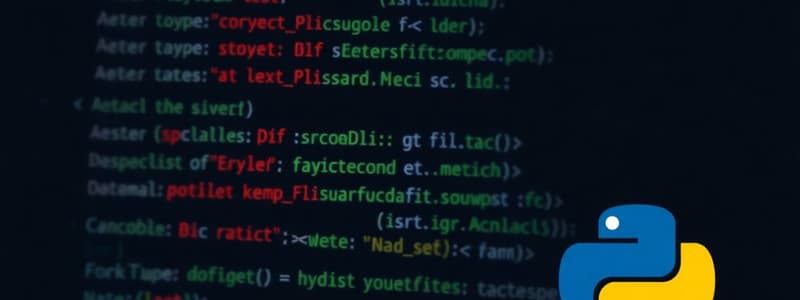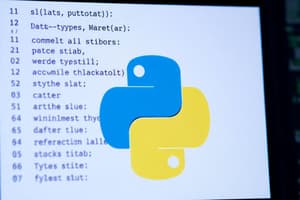Podcast
Questions and Answers
What will be the type of the variable 'z' if it is assigned the value -35.59?
What will be the type of the variable 'z' if it is assigned the value -35.59?
- String
- Complex
- Integer
- Float (correct)
Which of the following is a valid representation of a scientific number in Python?
Which of the following is a valid representation of a scientific number in Python?
- -20j
- -4.5i
- 2.2f
- 1.5e3 (correct)
What is the result of converting the float 2.8 to an integer using int()?
What is the result of converting the float 2.8 to an integer using int()?
- 0
- 3
- 2.8
- 2 (correct)
Which operator is used to perform exponentiation in Python?
Which operator is used to perform exponentiation in Python?
If 'x' is assigned the value 5 and 'y' is assigned the value 2, what will be the result of 'x % y'?
If 'x' is assigned the value 5 and 'y' is assigned the value 2, what will be the result of 'x % y'?
Which of the following correctly represents a complex number?
Which of the following correctly represents a complex number?
When performing floor division using '//' with operands 7 and 3, what is the result?
When performing floor division using '//' with operands 7 and 3, what is the result?
What will be the output of the expression '3 + 5j' when printed?
What will be the output of the expression '3 + 5j' when printed?
What will be the result of the expression 13 < 33?
What will be the result of the expression 13 < 33?
Which logical operator will yield False if both operands are True?
Which logical operator will yield False if both operands are True?
What will be the result of the expression not (13 < 33)?
What will be the result of the expression not (13 < 33)?
How does the expression x >= y evaluate when x is 20 and y is 20?
How does the expression x >= y evaluate when x is 20 and y is 20?
What does the != operator do in Python?
What does the != operator do in Python?
What character is used to create a tuple?
What character is used to create a tuple?
How do you create a tuple containing a single value?
How do you create a tuple containing a single value?
Which operation is NOT supported by tuples?
Which operation is NOT supported by tuples?
What will happen if you try to delete an individual element from a tuple?
What will happen if you try to delete an individual element from a tuple?
How would you access the second element of a tuple named 'my_tuple'?
How would you access the second element of a tuple named 'my_tuple'?
What is the result of the following code: 'tup3 = tup1 + tup2' where tup1 = (1, 2) and tup2 = (3, 4)?
What is the result of the following code: 'tup3 = tup1 + tup2' where tup1 = (1, 2) and tup2 = (3, 4)?
What Python command is used to delete an entire tuple?
What Python command is used to delete an entire tuple?
Given the tuple 'tup1 = ('hello', 'world')', what would 'tup1[0]' return?
Given the tuple 'tup1 = ('hello', 'world')', what would 'tup1[0]' return?
What will be the output of the expression $10 + 20 * 30$?
What will be the output of the expression $10 + 20 * 30$?
In the expression if name == 'Alex' or name == 'John' and age >= 2, what will be the output if name is 'Alex' and age is 0?
In the expression if name == 'Alex' or name == 'John' and age >= 2, what will be the output if name is 'Alex' and age is 0?
How does operator associativity determine the order of operations?
How does operator associativity determine the order of operations?
Which of the following best describes an arithmetic operator in Python?
Which of the following best describes an arithmetic operator in Python?
What type of operators would you use for logical evaluations like the one found in the provided code?
What type of operators would you use for logical evaluations like the one found in the provided code?
When age equals 2 in the same conditional statement, what will be the output if name is 'John'?
When age equals 2 in the same conditional statement, what will be the output if name is 'John'?
Which of the following statements about variable naming rules in Python is incorrect?
Which of the following statements about variable naming rules in Python is incorrect?
What is the primary purpose of Python keywords?
What is the primary purpose of Python keywords?
What is the output when the following code is executed: List = [1, 2, 4, 4, 3, 3, 3, 6, 5]; print(List)?
What is the output when the following code is executed: List = [1, 2, 4, 4, 3, 3, 3, 6, 5]; print(List)?
Which of the following demonstrates the mutability of lists in Python?
Which of the following demonstrates the mutability of lists in Python?
What is the result of the operation a = [1, 2, 3]; b = [4, 5, 6]; c = a + b; print(c)?
What is the result of the operation a = [1, 2, 3]; b = [4, 5, 6]; c = a + b; print(c)?
What will print(List[1:3]) output if List = ['a', 'b', 'c', 'd', 'e', 'f']?
What will print(List[1:3]) output if List = ['a', 'b', 'c', 'd', 'e', 'f']?
Which statement correctly explains the purpose of the len() function in relation to lists?
Which statement correctly explains the purpose of the len() function in relation to lists?
What is the output of print(List[:]) if List = ['a', 'b', 'c', 'd', 'e', 'f']?
What is the output of print(List[:]) if List = ['a', 'b', 'c', 'd', 'e', 'f']?
When using the * operator on a list like a = [1]; a = a * 3, what will be the output of print(a)?
When using the * operator on a list like a = [1]; a = a * 3, what will be the output of print(a)?
What happens when you execute List[1:3] = ['x', 'y'] on List = ['a', 'b', 'c', 'd', 'e', 'f']?
What happens when you execute List[1:3] = ['x', 'y'] on List = ['a', 'b', 'c', 'd', 'e', 'f']?
Flashcards are hidden until you start studying
Study Notes
Data Types in Python
-
Python offers various data types, including integers, floats, complex numbers, and strings.
-
Integers are whole numbers, such as 10, -5, and 0.
-
Floats are decimal numbers, such as 1.5, -3.14, and 0.0001.
-
Floats can also be written in scientific notation using "e" to represent the power of 10. For example, 35e3 is equivalent to 35 * 10^3.
-
Complex numbers have a real and imaginary part and are represented with "j" for the imaginary part. For example, 3 + 5j represents a complex number with a real part of 3 and an imaginary part of 5.
-
Strings are sequences of characters enclosed in single or double quotes. For example, "Hello, World!", 'Python', and '123' are all strings.
Type Conversion
-
You can convert between data types using built-in functions like
int(),float(), andcomplex(). -
For instance,
float(10)will convert the integer 10 into the float 10.0.
Operators
- Operators are symbols used to perform operations on values and variables.
Arithmetic Operators
- Arithmetic operators perform mathematical operations like addition, subtraction, multiplication, division, floor division, modulus, and exponentiation.
Comparison Operators
-
Comparison operators compare values and return either
TrueorFalse. -
Operators include greater than (
>), less than (<), equal to (==), not equal to (!=), greater than or equal to (>=), and less than or equal to (<=).
Logical Operators
-
Logical operators combine conditional statements to create more complex conditions.
-
Operators include logical AND (
and), logical OR (or), and logical NOT (not).
Bitwise Operators
- Bitwise operators work on bits and perform bit-by-bit operations. They are primarily used for operating on binary numbers.
Operator Precedence and Associativity
- Operator Precedence dictates the order in which operators are evaluated in an expression. For example, multiplication usually has higher precedence than addition.
- Operator Associativity determines how operators of the same precedence are evaluated when they appear consecutively. It can be from left to right or from right to left.
Python Lists
-
Lists are ordered collections of items enclosed in square brackets (
[]). -
They can contain elements of different data types.
-
Lists are mutable, meaning you can change their elements after creation.
-
List operations: You can concatenate lists using the
+operator and repeat lists using the*operator. -
List slicing: You can access specific parts of a list using the slice operator (
:). For example,my_list[1:3]would extract elements at indices 1 and 2. -
List methods: Python provides various built-in methods for manipulating lists, such as
append(),insert(),remove(),sort(), etc.
Python Tuples
-
Tuples are similar to lists, but they are immutable, meaning you cannot change their elements after creation.
-
They are enclosed in parentheses (
()). -
Tuple operations: You can access tuple elements using indices and slice operators. You can also concatenate tuples using the
+operator. -
Important note: Tuples are often used to store related pieces of data because they prevent accidental modification.
Studying That Suits You
Use AI to generate personalized quizzes and flashcards to suit your learning preferences.




